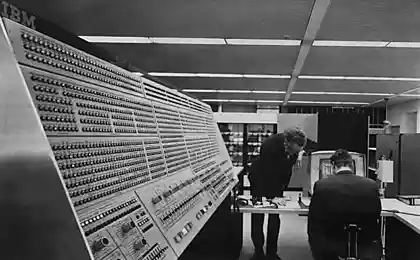584
The Zipf's law in city
During the last century, a mysterious mathematical phenomenon called Zipf's law, allowing with high accuracy to predict the change of the size of mega-cities around the world. The thing is that no one understands the how and why of the law...
Back in 1949. Linguist George Zipf (Zipf) noticed a strange trend in people use certain words in the language. He found that a small number of words used constantly, and the vast majority very rarely. If we evaluate the word popularity, and offering striking thing: the word of the first category is always used twice as often as the word of the second category and three times more often than the word the third category.
Zipf found that the same rule applies in the distribution of income of people in the country: the richest individual has twice as much money than the next rich guy and so on.

Later it became clear that this law also works in relation to the size of cities. The city with the largest population in any country is two times more than the next largest city and so on. Incredibly, the Zipf's law operated in all countries of the world over the past century.
Just look at the list of the largest cities in the United States. So, in accordance with the census of 2010, the population of the largest city in the U.S., new York is 8 175 133 people. Number two is Los Angeles with a population of 3 792 621 people. The following three cities, Chicago, Houston and Philadelphia, can boast a population of 2 695 598, 2 100 263 1 526 006, respectively. Obviously, these numbers are inaccurate, but, nevertheless, they surprisingly correspond to Zipf's law.
Paul Krugman, who wrote about applying Zipf's law to cities, some excellent points: economic theory is often accused of creating a highly simplified models of complex, messy reality. The Zipf's law shows that the situation is exactly the opposite: we apply is too complex, messy models, and the reality is startlingly neat and simple.
The law of force
In 1999, economist Xavier Gabe wrote a treatise, in which he described Zipf's law as the “law of force”.
Gabe noted that this law persists even if cities grow in a chaotic manner. But this smooth structure breaks down as soon as you go to cities that are not in the category of megacities. A small town with a population of about one hundred thousand people, apparently, are subject to another law and reveal a more understandable size distribution.

One may wonder what is meant by the definition of "city"? For example, Boston and Cambridge are considered two different cities, just like San Francisco and Oakland are separated by water.
Two Swedish geographers also ask this question, and they began to consider the so-called "natural" cities, the combined population and road chords, and not political motives. And they found that even such "natural" city obey Zipf's law.

Why Zipf's law works in the cities?
So what causes the city to be less predictable in the population? Nobody can explain it. We know that cities are expanding due to immigration, immigrants flock to large cities because there are more possibilities. But immigration is not enough to explain this law.
There are also economic reasons, as in big cities make a lot of money, and Zipf's law works for the distribution of income. However, a clear answer to the question it still does not.
Last year a group of researchers found that Zipf's law there are exceptions: the law only works if the cities are connected economically. This explains why the law is valid, for example, individual European countries, but not for the whole EU.
How cities thrive
There is another strange rule applicable to cities, it has to do with how cities consume resources when growing up. Growing up, cities become more stable. For example, if a city doubles in size, it requires the number of gas stations is not doubled.
The city will be quite comfortable to live, if the number of gas stations will increase by approximately 77%. At that time, as the Zipf's law follows certain social laws, this law is more close to nature, for example, to how animals consume energy and become more Mature.
Mathematician Stephen Strogatz describes it this way:
How many calories a day you need mouse compared to the elephant? They are both mammals, thus, it can be assumed that at the cellular level, they should not differ greatly. Indeed, if cultured cells of ten different mammals, all cells have the same metabolic rate, they are not characterized at the genetic level, what size is in fact their owner.
But if you take the elephant or the mouse as the threshold of functioning, the accumulation of billions of cells, the same effect cage the elephant will spend much less energy than the mouse cells. The law of metabolism, called Kleiber's law, States that the metabolic needs of a mammal grow in proportion to its body weight to 0.74 times.
These 0,74 0,77 very close to that observed in the law governing the number of gas stations in the city. Coincidence? Maybe, but probably not.
All this is terribly exciting, but perhaps less mysterious than Zipf's law. It's not hard to understand why the city is, in fact, the ecosystem, though built by humans, must obey the natural laws of nature. But Zipf's law has no analogue in nature. It is a social phenomenon and it occurs only during the last hundred years.
All we know is that Zipf's law applies to other social systems, including economic and linguistic. Thus, it is possible, there are some General social rules that create this strange law, and someday we will be able to understand them. The one who will solve this puzzle, you may find the key to the prediction of much more important things than urban growth. The Zipf's law may be only a small aspect of the global rules of social dynamics, which determines the way we communicate, trade, formed by community and so much more.published
SUBSCRIBE to OUR youtube channel that allows you to watch online, download from YouTube free video about the recovery, the rejuvenation of man. Love for others and ourselves, as the feeling of high vibrations — an important factor in recovery — EN
Put LIKES and share with your FRIENDS!
www.youtube.com/channel/UCXd71u0w04qcwk32c8kY2BA/videos
Subscribe -https://www.facebook.com//
P. S. And remember, only by changing their consumption — together we change the world! ©
Join us in Facebook , Vkontakte, Odnoklassniki
Source: masterok.livejournal.com/2824971.html
Back in 1949. Linguist George Zipf (Zipf) noticed a strange trend in people use certain words in the language. He found that a small number of words used constantly, and the vast majority very rarely. If we evaluate the word popularity, and offering striking thing: the word of the first category is always used twice as often as the word of the second category and three times more often than the word the third category.
Zipf found that the same rule applies in the distribution of income of people in the country: the richest individual has twice as much money than the next rich guy and so on.

Later it became clear that this law also works in relation to the size of cities. The city with the largest population in any country is two times more than the next largest city and so on. Incredibly, the Zipf's law operated in all countries of the world over the past century.
Just look at the list of the largest cities in the United States. So, in accordance with the census of 2010, the population of the largest city in the U.S., new York is 8 175 133 people. Number two is Los Angeles with a population of 3 792 621 people. The following three cities, Chicago, Houston and Philadelphia, can boast a population of 2 695 598, 2 100 263 1 526 006, respectively. Obviously, these numbers are inaccurate, but, nevertheless, they surprisingly correspond to Zipf's law.
Paul Krugman, who wrote about applying Zipf's law to cities, some excellent points: economic theory is often accused of creating a highly simplified models of complex, messy reality. The Zipf's law shows that the situation is exactly the opposite: we apply is too complex, messy models, and the reality is startlingly neat and simple.
The law of force
In 1999, economist Xavier Gabe wrote a treatise, in which he described Zipf's law as the “law of force”.
Gabe noted that this law persists even if cities grow in a chaotic manner. But this smooth structure breaks down as soon as you go to cities that are not in the category of megacities. A small town with a population of about one hundred thousand people, apparently, are subject to another law and reveal a more understandable size distribution.

One may wonder what is meant by the definition of "city"? For example, Boston and Cambridge are considered two different cities, just like San Francisco and Oakland are separated by water.
Two Swedish geographers also ask this question, and they began to consider the so-called "natural" cities, the combined population and road chords, and not political motives. And they found that even such "natural" city obey Zipf's law.

Why Zipf's law works in the cities?
So what causes the city to be less predictable in the population? Nobody can explain it. We know that cities are expanding due to immigration, immigrants flock to large cities because there are more possibilities. But immigration is not enough to explain this law.
There are also economic reasons, as in big cities make a lot of money, and Zipf's law works for the distribution of income. However, a clear answer to the question it still does not.
Last year a group of researchers found that Zipf's law there are exceptions: the law only works if the cities are connected economically. This explains why the law is valid, for example, individual European countries, but not for the whole EU.
How cities thrive
There is another strange rule applicable to cities, it has to do with how cities consume resources when growing up. Growing up, cities become more stable. For example, if a city doubles in size, it requires the number of gas stations is not doubled.
The city will be quite comfortable to live, if the number of gas stations will increase by approximately 77%. At that time, as the Zipf's law follows certain social laws, this law is more close to nature, for example, to how animals consume energy and become more Mature.
Mathematician Stephen Strogatz describes it this way:
How many calories a day you need mouse compared to the elephant? They are both mammals, thus, it can be assumed that at the cellular level, they should not differ greatly. Indeed, if cultured cells of ten different mammals, all cells have the same metabolic rate, they are not characterized at the genetic level, what size is in fact their owner.
But if you take the elephant or the mouse as the threshold of functioning, the accumulation of billions of cells, the same effect cage the elephant will spend much less energy than the mouse cells. The law of metabolism, called Kleiber's law, States that the metabolic needs of a mammal grow in proportion to its body weight to 0.74 times.
These 0,74 0,77 very close to that observed in the law governing the number of gas stations in the city. Coincidence? Maybe, but probably not.
All this is terribly exciting, but perhaps less mysterious than Zipf's law. It's not hard to understand why the city is, in fact, the ecosystem, though built by humans, must obey the natural laws of nature. But Zipf's law has no analogue in nature. It is a social phenomenon and it occurs only during the last hundred years.
All we know is that Zipf's law applies to other social systems, including economic and linguistic. Thus, it is possible, there are some General social rules that create this strange law, and someday we will be able to understand them. The one who will solve this puzzle, you may find the key to the prediction of much more important things than urban growth. The Zipf's law may be only a small aspect of the global rules of social dynamics, which determines the way we communicate, trade, formed by community and so much more.published
SUBSCRIBE to OUR youtube channel that allows you to watch online, download from YouTube free video about the recovery, the rejuvenation of man. Love for others and ourselves, as the feeling of high vibrations — an important factor in recovery — EN
Put LIKES and share with your FRIENDS!
www.youtube.com/channel/UCXd71u0w04qcwk32c8kY2BA/videos
Subscribe -https://www.facebook.com//
P. S. And remember, only by changing their consumption — together we change the world! ©
Join us in Facebook , Vkontakte, Odnoklassniki
Source: masterok.livejournal.com/2824971.html























